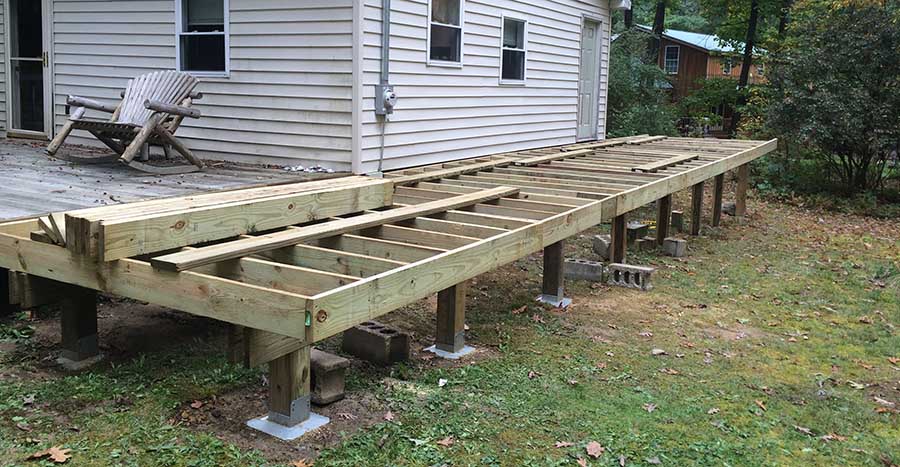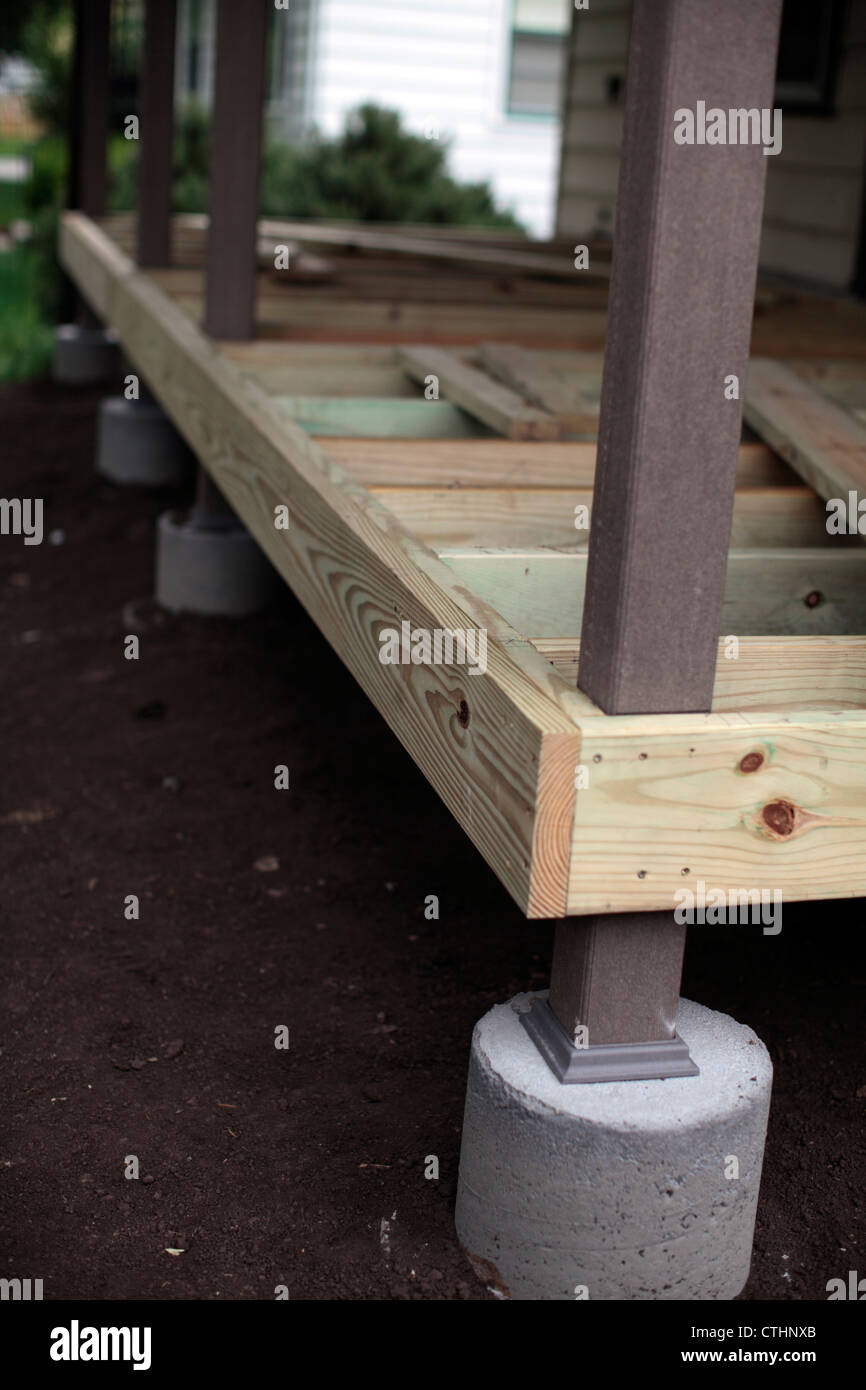Selecting the Right Deck Footings for Stability and Durability
The long life and security of your deck depend greatly on the type of grounds you pick, as they provide the essential support and security to hold up against the examination of time. In this discussion, we will certainly check out the different kinds of deck grounds, think about the essential elements to weigh when making a decision, and dig right into the pros and cons of different options.
Types of Deck Grounds
These footings are composed of a round hole filled with concrete, which provides a strong structure for the deck blog posts. Concrete pier footings are fairly easy to set up and provide excellent security, making them a prominent selection for numerous deck tasks.
These footings are set up by screwing them right into the ground, which creates a safe and secure structure for the deck. They likewise allow for simple modification and progressing of the deck if needed.
Alternatively, some building contractors go with precast concrete grounds. These footings are constructed from durable concrete and come in various forms and sizes to accommodate various deck layouts. Precast concrete footings are hassle-free to set up and give a steady base for the deck structure.
Ultimately, another option is the post-in-anchor ground system. This kind of ground includes driving a steel support into the ground and affixing it to the deck article. It uses adaptability in terms of positioning the deck articles and is ideal for decks with lightweight frameworks.
When picking the right sort of deck ground, it is vital to think about variables such as soil conditions, deck tons, and regional building regulations (Deck Footings). Consulting with an expert contractor or architectural engineer can assist guarantee the proper ground is chosen for a risk-free and stable deck
Elements to Take Into Consideration When Picking Grounds
When picking the proper footings for a deck, it is critical to carefully take into consideration numerous elements such as soil conditions, deck lots, and adherence to neighborhood building regulations. These factors play a significant function in making certain the stability and longevity of the deck structure.
Among the key factors to think about is the dirt problems. The kind of dirt on which the deck will be developed identifies the sort of footings called for. Decks developed on loosened or sandy soils may require much deeper grounds to offer appropriate support and stop settling. On the various other hand, decks built on clay or extensive dirts might call for grounds that can suit the soil's propensity to increase and contract.
An additional essential variable is the deck lots. The weight of the deck, including the materials used and any potential online loads such as furnishings or gatherings, need to be considered when selecting grounds. The footings need to be created to birth the weight of the deck and disperse it evenly to prevent any type of structural concerns or failures.
Lastly, adherence to neighborhood building regulations is vital. Building ordinance vary from region to area, and it is vital to abide with the particular requirements set by the neighborhood authorities. Deck Footings. These codes make certain that the deck is developed securely and meets the necessary criteria for architectural stability and load-bearing capacity
Concrete Footings: Cons and pros

Concrete grounds provide numerous benefits and downsides when made use of as the foundation web link for a deck. On the silver lining, concrete grounds supply superb stability and resilience. Concrete is a inflexible and strong product that can sustain heavy loads and hold up against various weather problems. It also has a long lifespan, making it a trusted choice for lasting use.
Another advantage of concrete grounds is their adaptability. They can be put into various shapes and dimensions to accommodate different deck designs and configurations. Concrete footings can be customized to fit the details demands and needs of the deck structure.
However, there are likewise some downsides to using concrete grounds. This can increase the overall price of the deck task and might need specialist aid.

Helical Piers Vs. Sonotubes: Which Is Better?
In considering the foundation alternatives for a deck, the comparison in between helical piers and sonotubes is important in establishing the superior option. Helical piers, also referred to as screw stacks, are steel shafts with helical plates affixed to them. They are turned right into the ground utilizing hydraulic machinery, providing a durable and stable structure for the deck. On the other hand, sonotubes are cylindrical kinds made from cardboard or fiber material that are loaded with concrete. They are positioned in an opening dug into the ground and offer support for the deck.
When it concerns security and longevity, helical piers have the upper hand. The helical plates on the piers produce a solid grip with the soil, stopping any kind of motion or shifting of the deck. This is particularly advantageous in locations with unpredictable or moving dirt conditions. Sonotubes, on the other hand, rely entirely on the concrete filling for security, Find Out More which may not provide the very same degree of strength and resistance.
In terms of installment, helical piers are you could try these out reasonably less complicated and faster to mount contrasted to sonotubes. The hydraulic equipment used to twist the piers into the ground guarantees a efficient and quick procedure. Sonotubes, on the other hand, need digging openings and pouring concrete, which can be labor-intensive and lengthy.
Additionally, helical piers are a more functional alternative. If required, they can be utilized in different dirt conditions and can be adjusted or reinforced. Sonotubes, on the various other hand, might require additional support, such as rebar, in particular dirt problems or locations with high lots requirements.
Selecting the Right Footings for Your Deck's Measurements
For optimal architectural integrity, it is important to thoroughly select the appropriate grounds that straighten with the measurements of your deck. The dimensions of your deck, including its size, length, and elevation, play a substantial duty in determining the type and size of grounds called for.
When picking footings for your deck, it is important to take into consideration the load-bearing capability of the dirt. The weight of the deck, combined with the weight of any furniture or individuals on it, applies a considerable force on the footings (Deck Footings). It is essential to select grounds that can appropriately sustain this weight without changing or sinking over time.
Bigger decks with greater dimensions need bigger footings to give adequate security and support. The shape of the footings, whether they are square or rounded, depends on the layout and format of the deck.
Conclusion
In conclusion, selecting the appropriate deck grounds is important for making certain stability and durability. Elements such as the type of grounds, the deck's measurements, and the pros and cons of various options must be taken into consideration. Concrete footings offer stamina and durability, however may be much more costly and lengthy to install. Helical piers and sonotubes have their very own benefits and disadvantages. Ultimately, choosing the appropriate footings for your deck's details requirements is vital for a long-lasting and successful framework.
These footings consist of a round hole filled with concrete, which supplies a strong foundation for the deck posts. Concrete pier grounds are reasonably easy to set up and use exceptional stability, making them a prominent option for many deck tasks.
Precast concrete footings are practical to mount and provide a stable base for the deck framework.
It provides versatility in terms of positioning the deck articles and is ideal for decks with light-weight frameworks.
Concrete footings use several benefits and negative aspects when made use of as the structure for a deck.